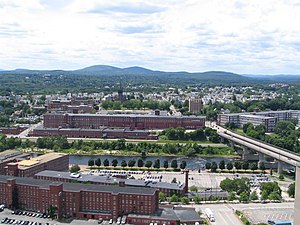Amoskeag Manufacturing Company

The Amoskeag Mills circa 2006
|
|
| Industry | Textiles Locomotives |
|---|---|
| Fate | Bankrupted |
| Predecessor | Amoskeag Cotton & Woolen Manufacturing Company |
| Successor | Amoskeag Company |
| Founded | 1810 |
| Founder | Benjamin Prichard |
| Headquarters | Manchester, New Hampshire |
The Amoskeag Manufacturing Company was a textile manufacturer which founded Manchester, New Hampshire. From modest beginnings in near wilderness, it grew throughout the 19th century into the largest cotton textile plant in the world. At its peak, Amoskeag was unrivaled both for the quality and quantity of its products. But with great size came an inability to adapt. In the early 20th century, the business failed in changing economic and social conditions.
In May 1807, Samuel Blodget completed a canal and lock system beside the Merrimack River at Derryfield. His enterprise allowed boats traveling between Concord and Nashua to bypass Amoskeag Falls, opening the region to development. Blodget envisioned here "the Manchester of America," a water-powered textile center comparable to the Industrial Revolution English city he had recently visited. The name stuck, and in 1810 Derryfield was changed to Manchester. That same year, Benjamin Prichard and others incorporated the Amoskeag Cotton & Woolen Manufacturing Company. He and three brothers—Ephraim, David and Robert Stevens—had purchased land and water power rights the year before on the west bank of the Merrimack near Amoskeag Bridge, where they built a mill. From Samuel Slater they bought second-hand mill machinery, but it didn't work well. In 1811, new machinery was built to spin cotton into yarn, the currency with which factory wages and dividends were paid. Weaving became a cottage industry for local women, who earned between 2 and 7 cents per yard, depending on the type of fabric. A good weaver could average 10 to 12 yards (11 m) per day.
...
Wikipedia
